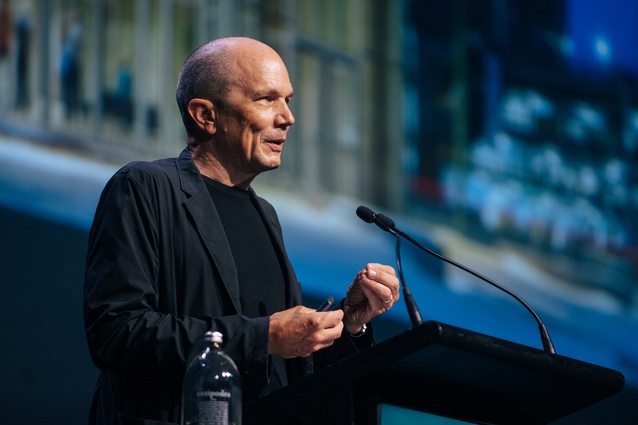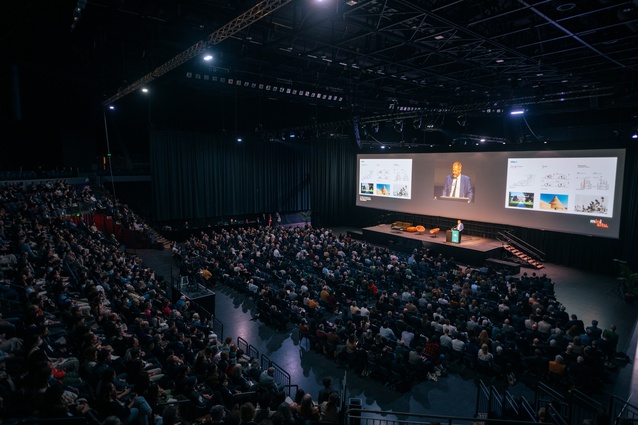Mini in:situ – A report on experience
Isaac Sweetapple attends his first-ever architecture conference. Thinking through what sets this type of event apart from those hosted outside the Institute’s reach, he observes a fracturing between different attitudes towards sustainability and socialising, validity and value, temperament and taste, discourse and dialogue.
Upon entering Auckland’s Spark Arena for mini in:situ – Aotearoa’s largest architecture conference, hosted by Te Kāhui Whaihanga New Zealand Institute of Architects – I found myself immersed in a trade show; even outside of the office, the sales pitches are inescapable. After weaving my way through the irl spec sheet, I found my way up into the stands. Watching members of the crowd meander to their seats, I began to wonder why the NZIA had chosen these four international speakers. What insights did they have to offer and how could these be applied to Aotearoa’s built environment?
As the broken murmurs were lulled by TV personality Jehan Casinader and the collective mourning commenced, it became clear that, for some of us, this was possibly more than a branding exercise. Armed with a tote full of freebies and a notes app of targeted questions, I silenced my little corner of the internet and prepared to hook myself up to the communal content drip.
In typical pandemic fashion, Anne Lacaton joined us over Zoom, presenting a series of projects that highlighted her practice’s uncompromising commitment to strategic refurbishment across an array of social housing projects. Lacaton’s ability to rejuvenate the modernist qualities of large-scale renovation projects was both spatially and logistically impressive. The all-too-familiar pitfalls of videoconferencing began to appear during question time. Despite harbouring a healthy portion of pessimism, I was charmed by Lacaton’s work. The coffee had kicked in and we were off to a good start.
Up next was Bologna-based architect Mario Cucinella. Full of witty half-truths, Cucinella touched on the anxiety one faces in the architectural profession. Once his extended book pitch was out of the way, Cucinella alluded, with a chatty familiarity, to the many dangers of practicing architecture, whilst simultaneously encouraging the audience to “imagine a world where beauty is soulful and sustainable”. But, as Cucinella’s 3D printer went brrrrrr, slithers of cynicism began to seep back into frame.
It was no coincidence that, earlier in the week, feathers had been ruffled as murmurs proliferated throughout social media that another conference – pre:fab – was set to take place that coming weekend. Hosted by The Night School and friends, pre:fab screened freely accessible lectures by the same four architects in an effort to cultivate an active dialogue with attendees, many of whom were priced out of attending the Institute’s event.
After lunch, we were treated to a presentation packed full of high glycemic index (capital A) architecture. Odile Decq served up an array of luxury architectural objects that were fun for a fleeting moment but lacked any real sustenance. In an ode to a time before, Decq took full advantage of the passive audience of 1200. Leaving no time to be questioned on her work or views, Decq would go on to proclaim that “Architecture is not a profession, it’s a passion; it’s life”. All this left me with a bitter taste in my mouth. I couldn’t help but feel that the one positive takeaway from Decq’s talk was that it gave many of us – especially those of us who favour two wheels – something to stand against, collectively.
The fourth and final speaker was Los Angeles-based Michael Maltzan, who started on a trajectory similar to that of Decq, presenting a surreal beachfront residence in Malibu that was jam-packed full of spatial opulence. Despite this misstep, Maltzan’s social housing and infrastructure projects appeared to embrace a level of complexity that would deservedly prompt a lively discussion in the office the next morning. I wonder whether or not he had the opportunity to check out the Māngere Bridge on his way back to the airport.
Meanwhile, behind the screen on the trade-room floor, we began to hear a symphony of clinking and mumbled chatter. It was 5pm. Maltzan was just starting to roll but those running the trade show had clocked off and, like the rest of us, were keen to shoot the shit. Final catch-ups were had amongst scaffolds of the expo. For many, especially those delegations from the provinces, it seemed that this was one of the highlights of the architectural calendar. Fiscal gatekeeping aside, mini in:situ had fostered a sense of community within a portion of a profession that can feel atomised at the best of times.











